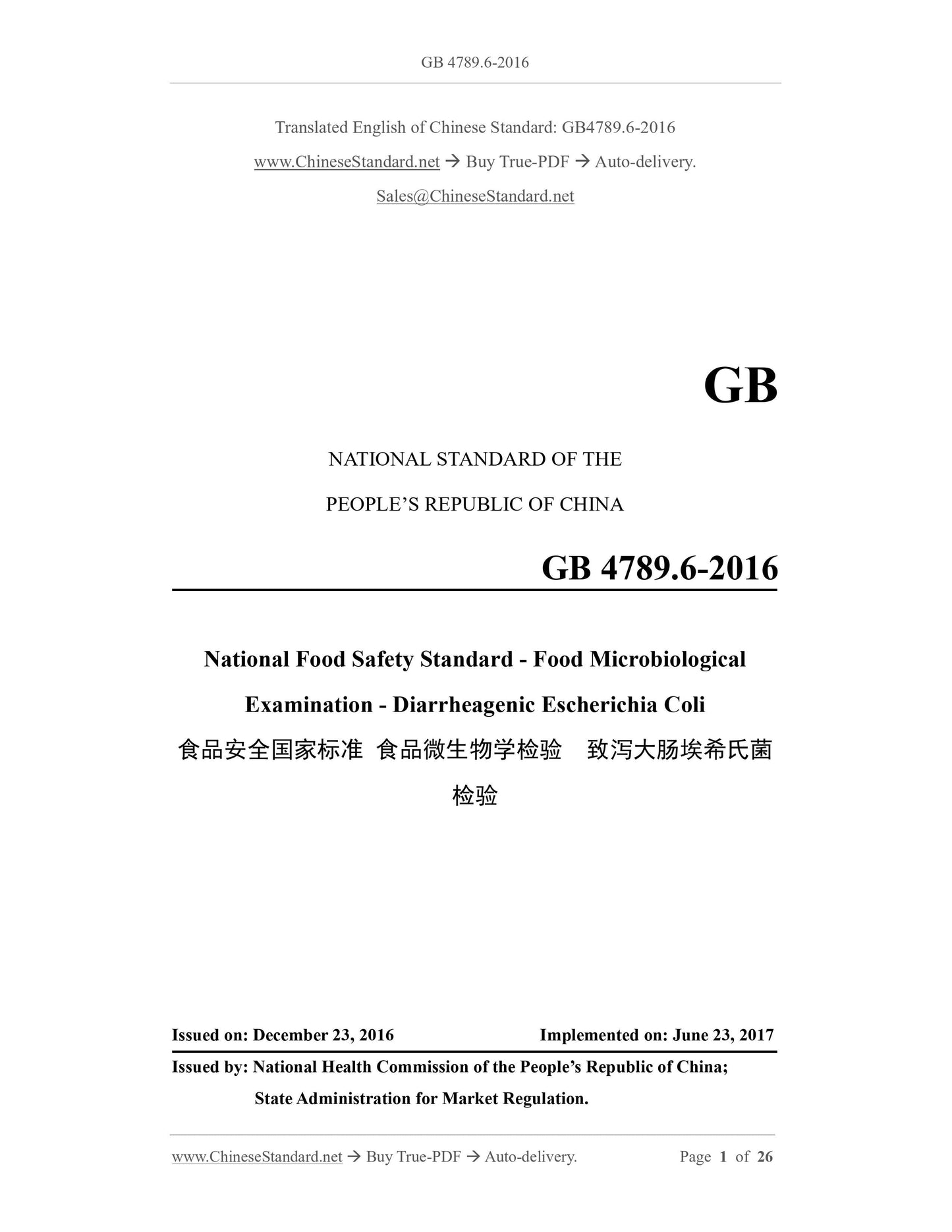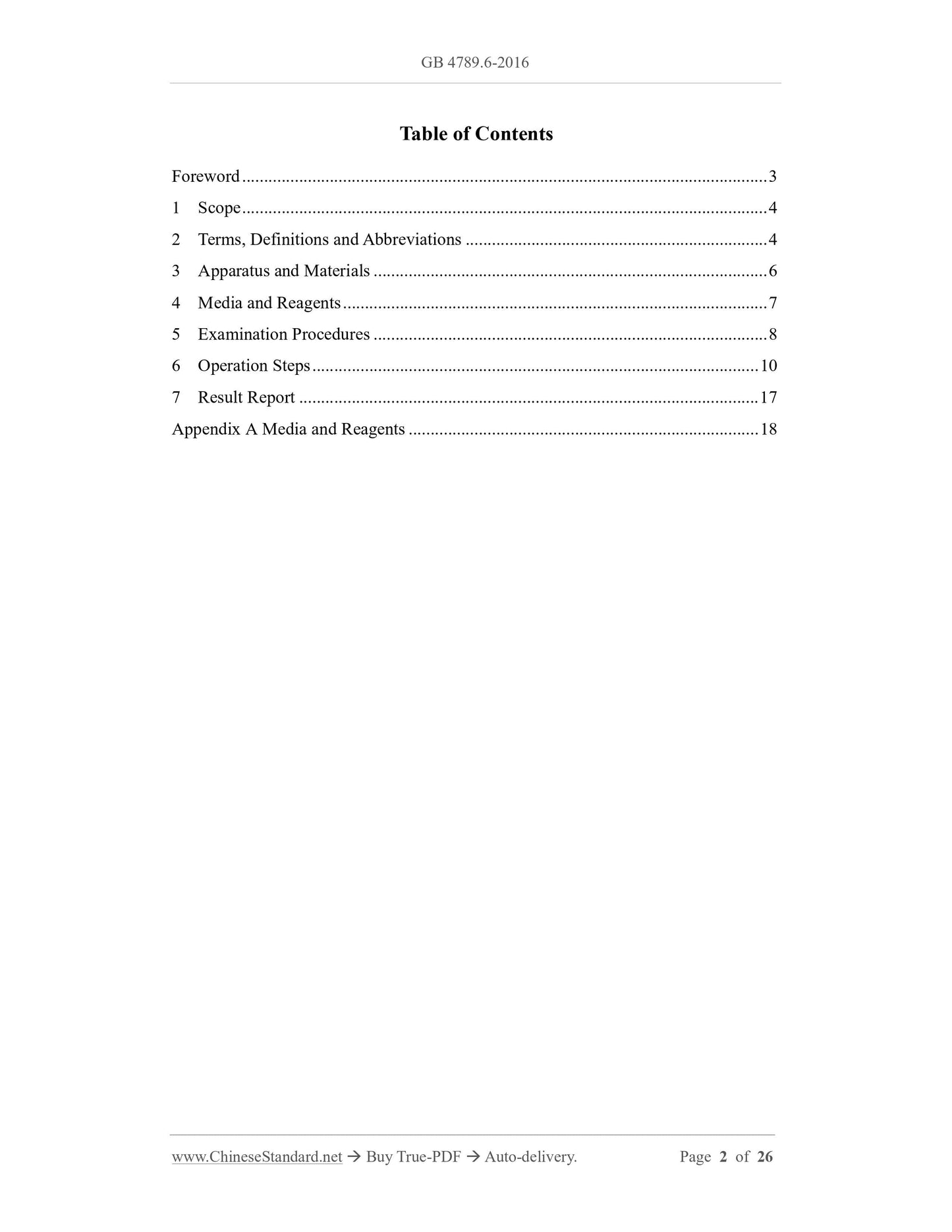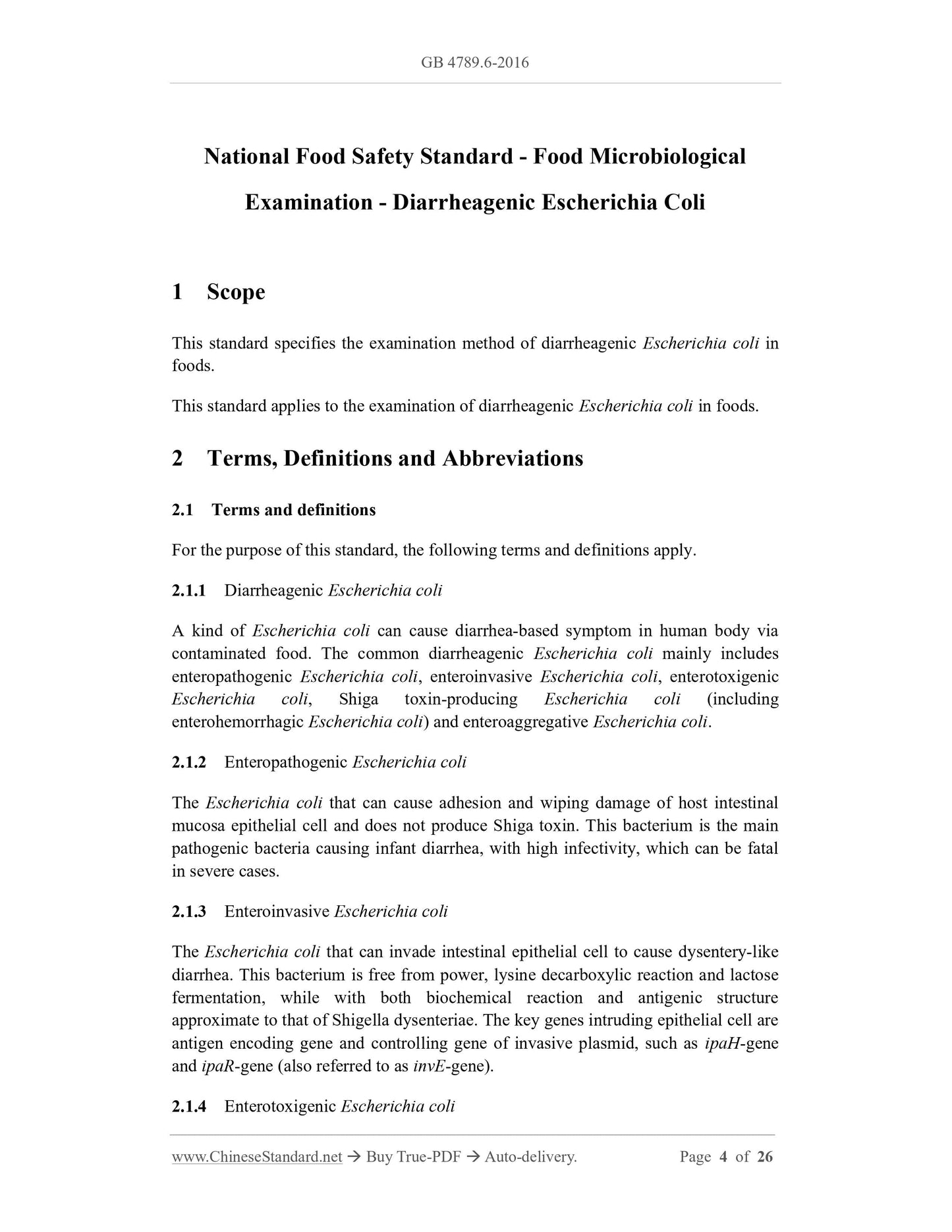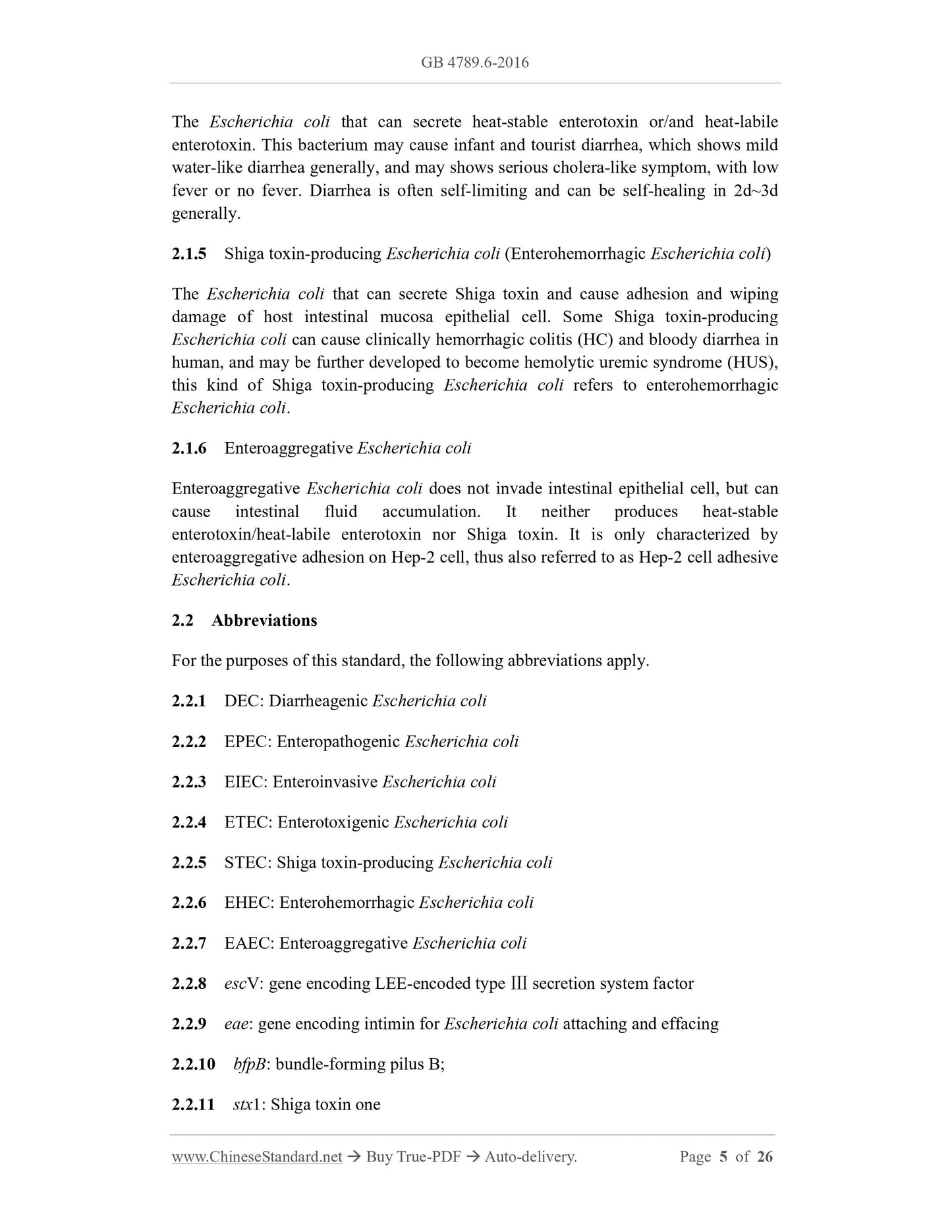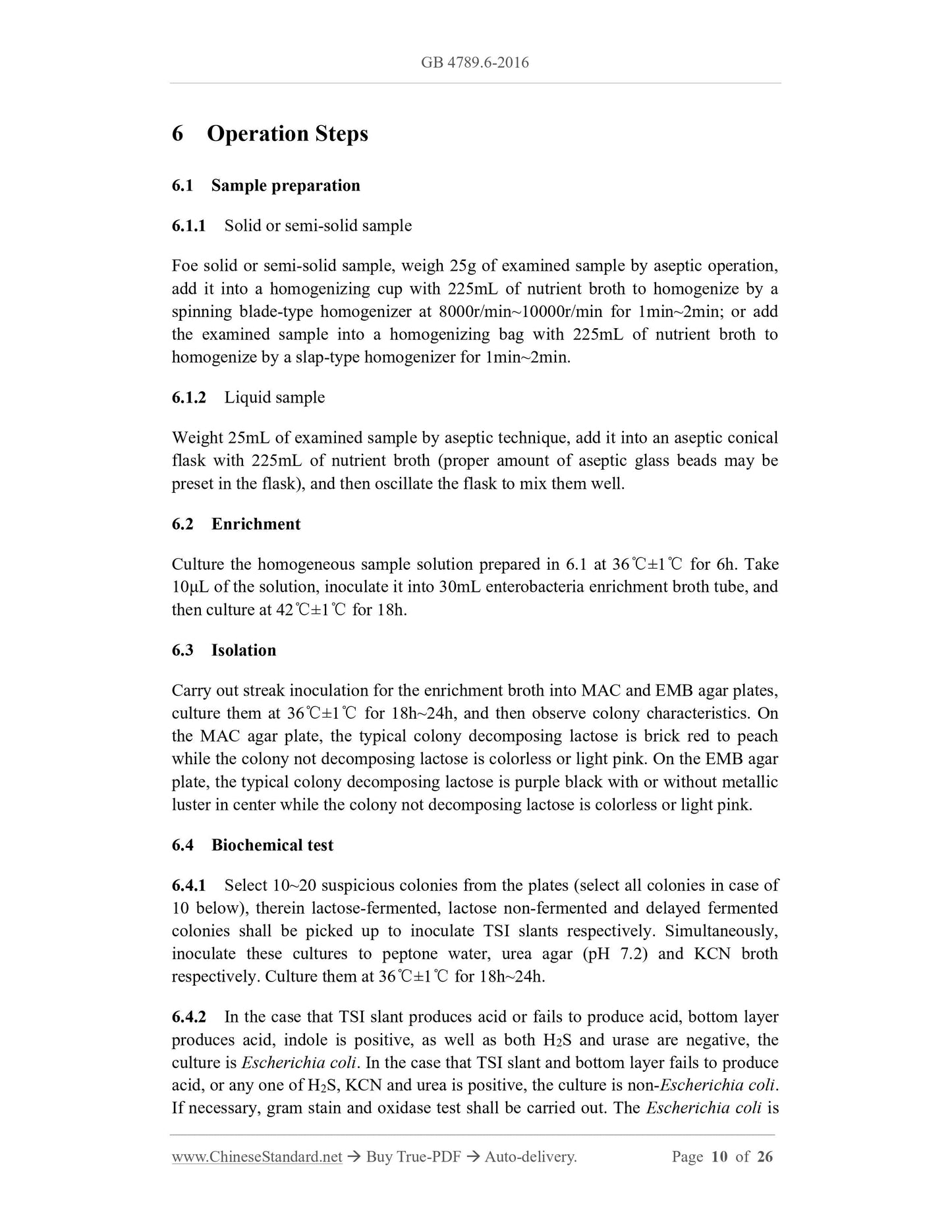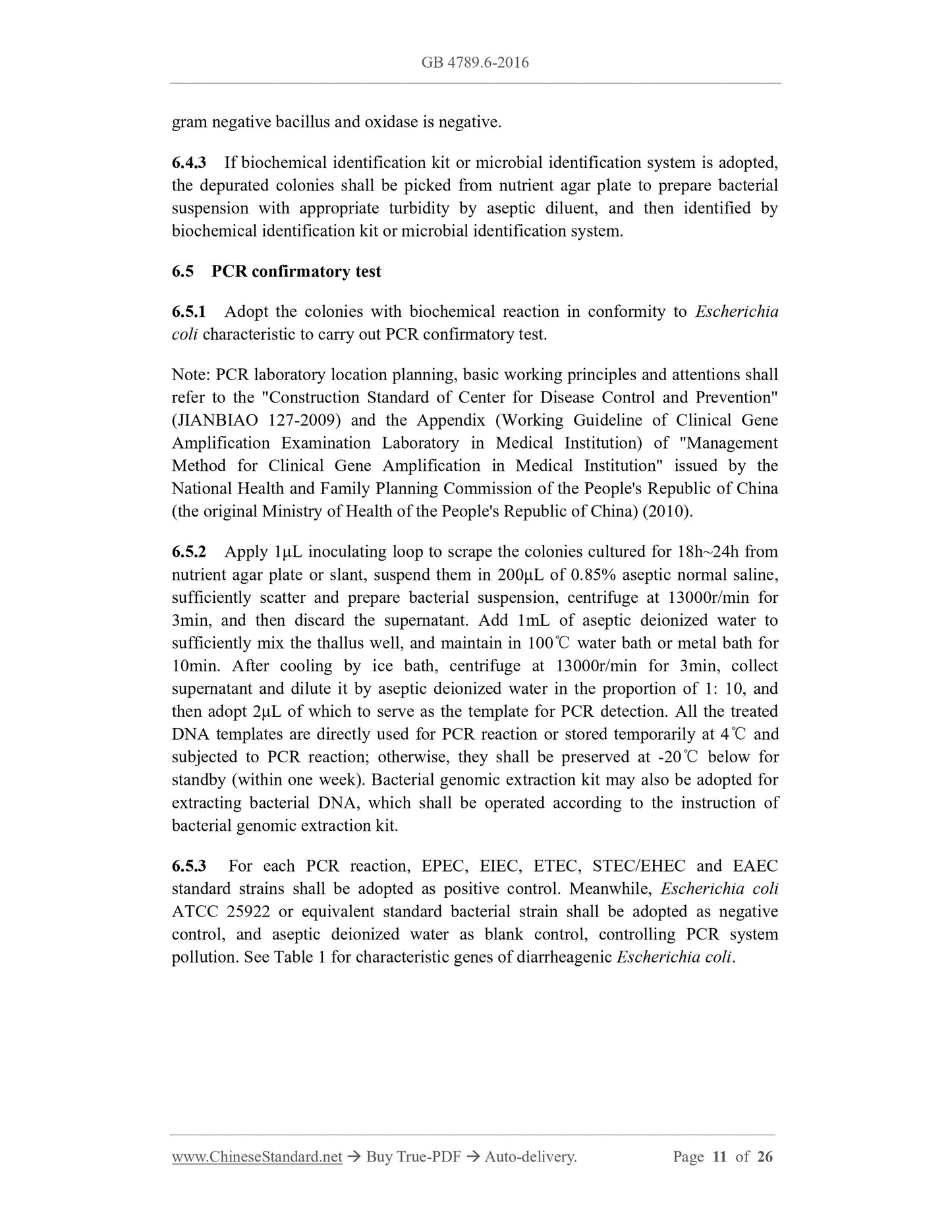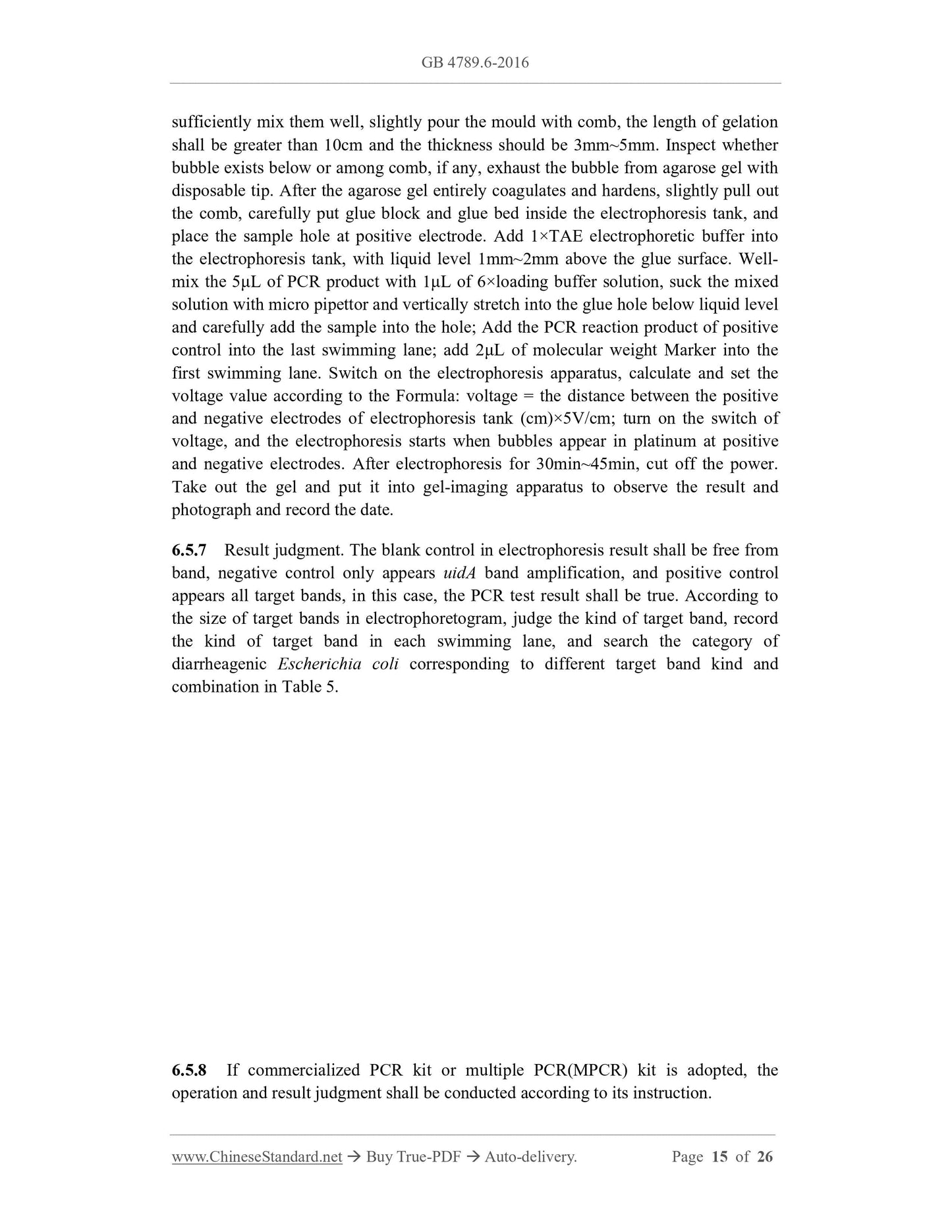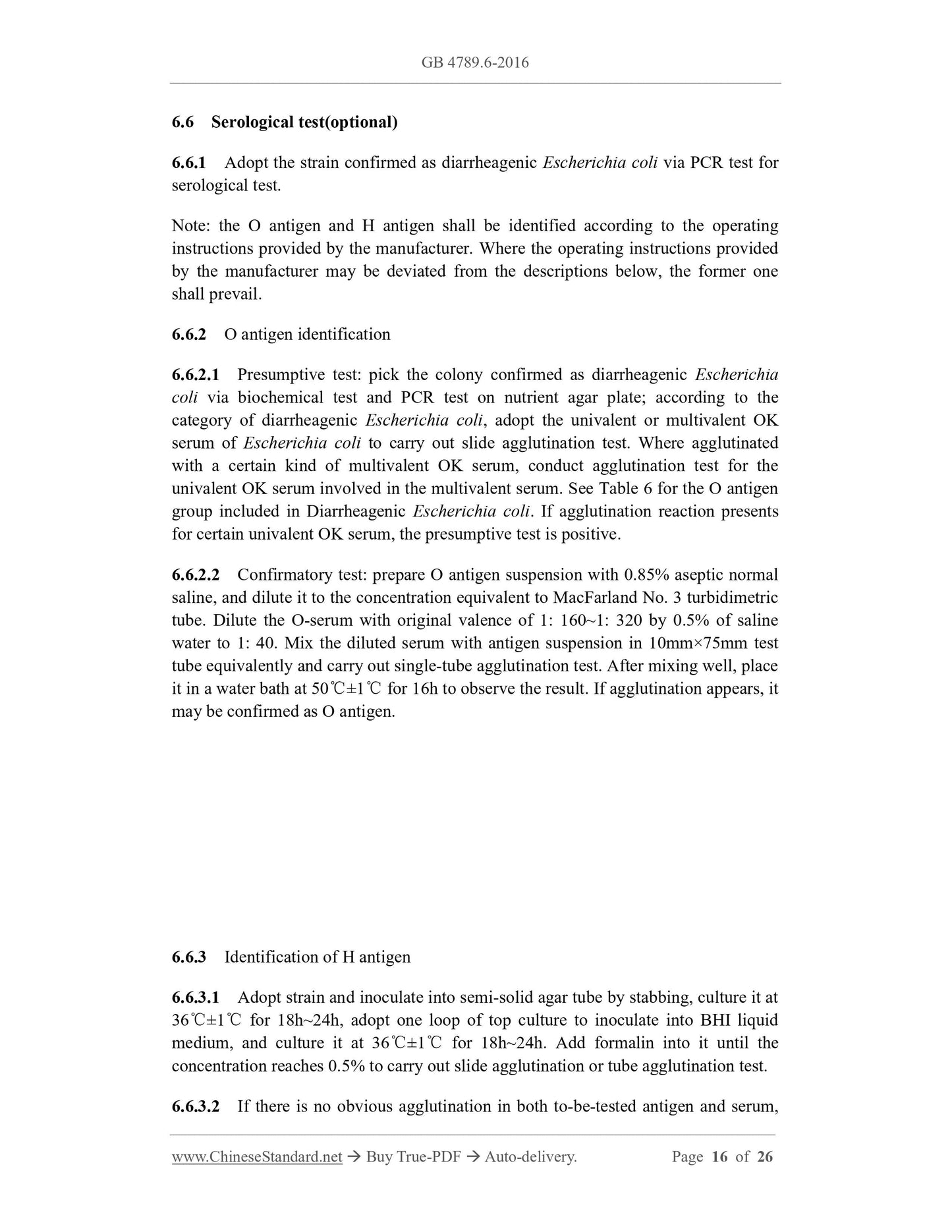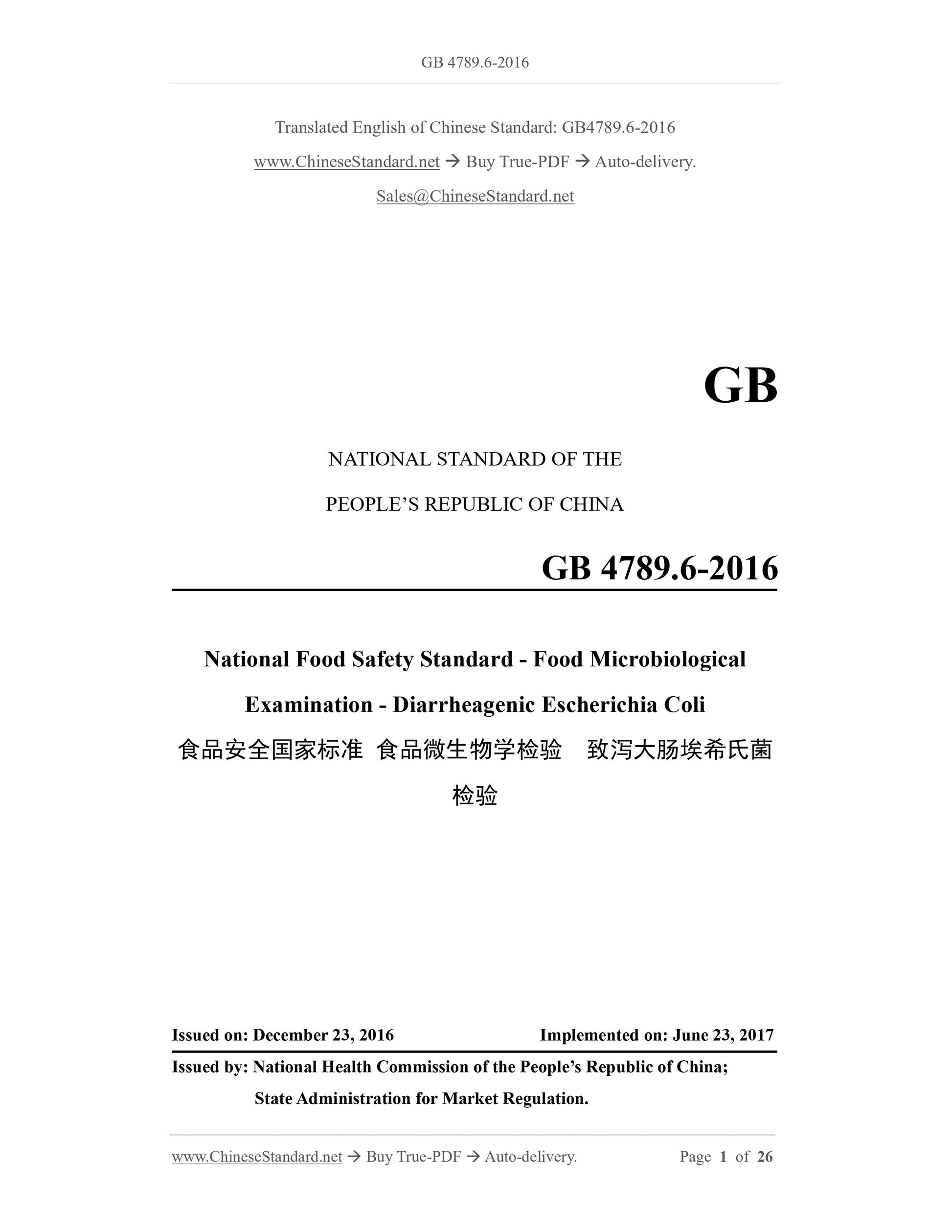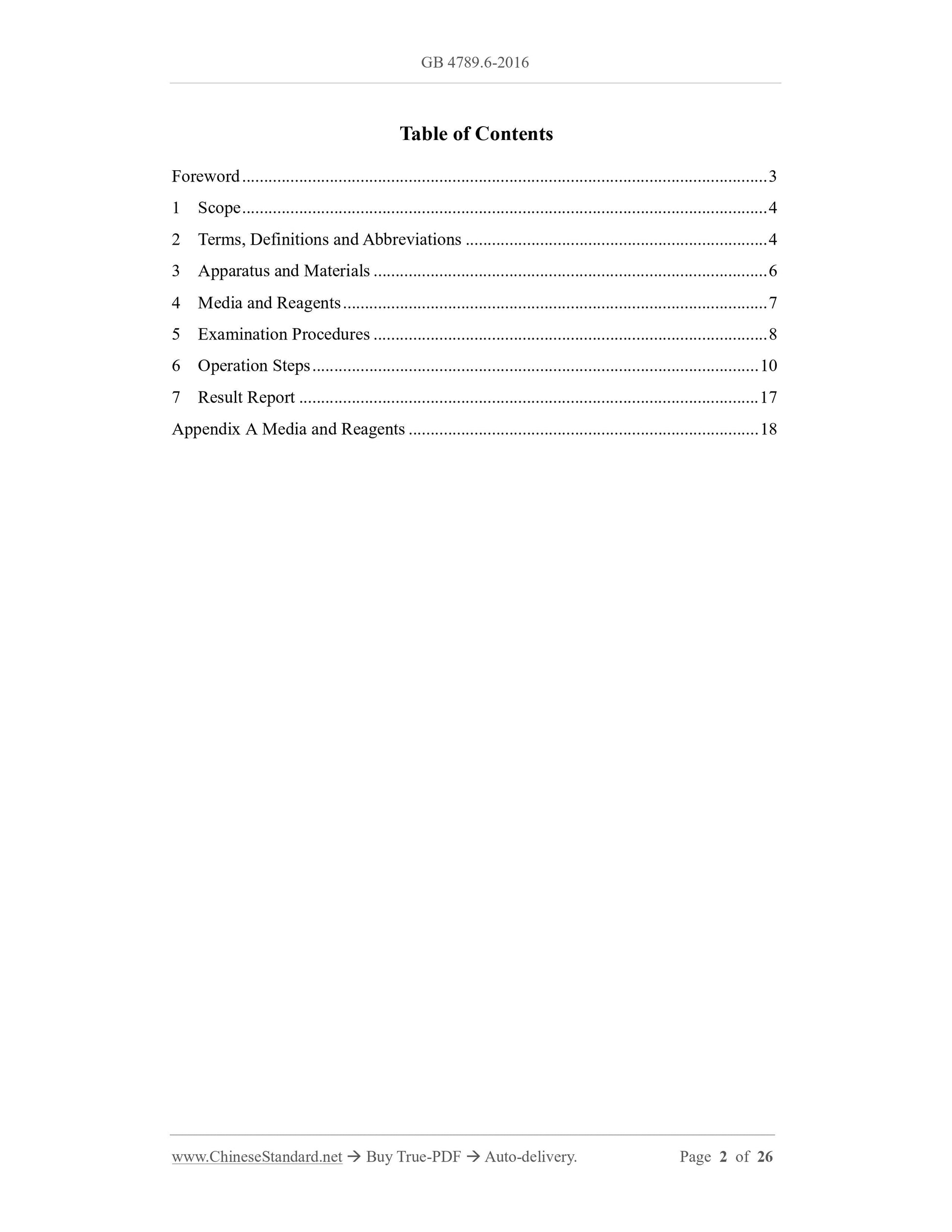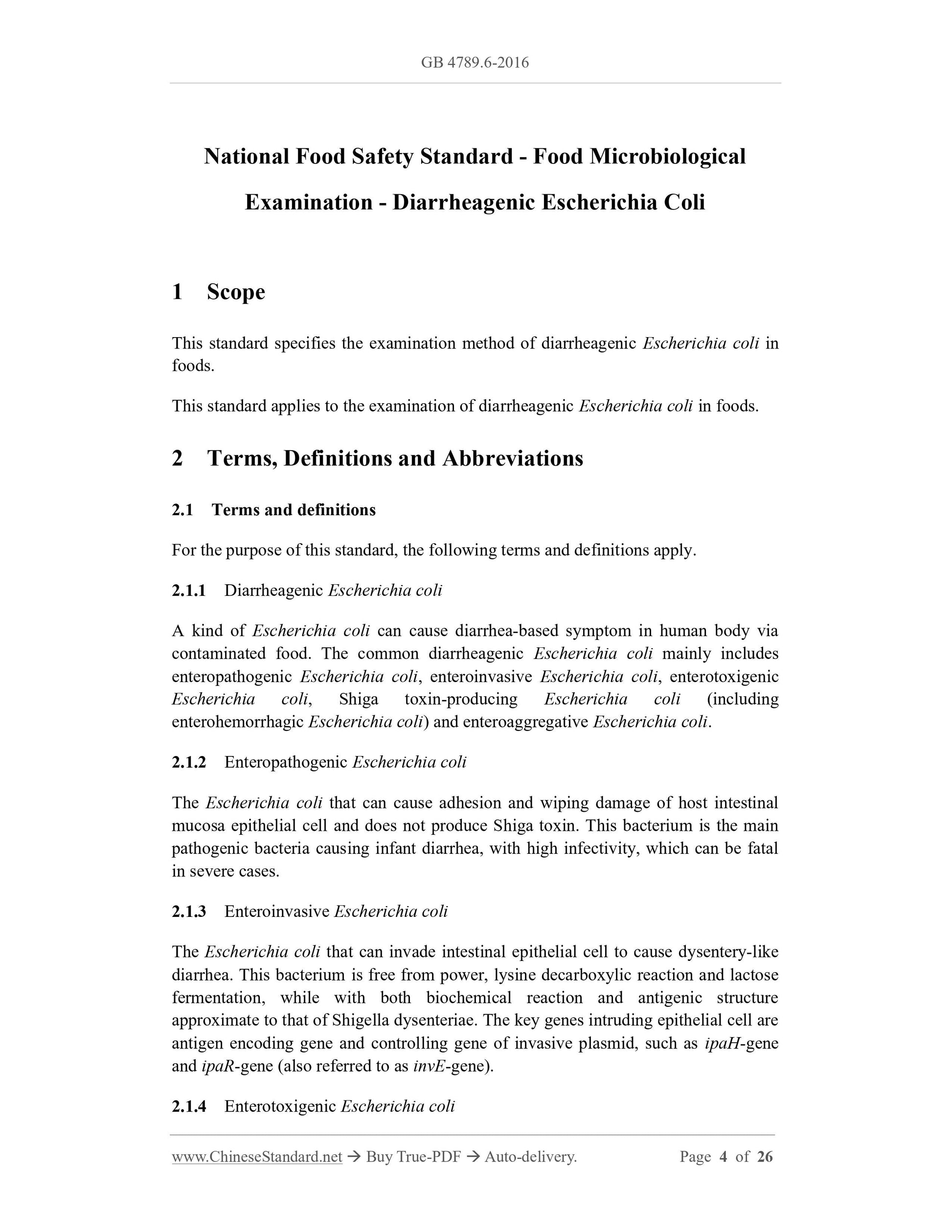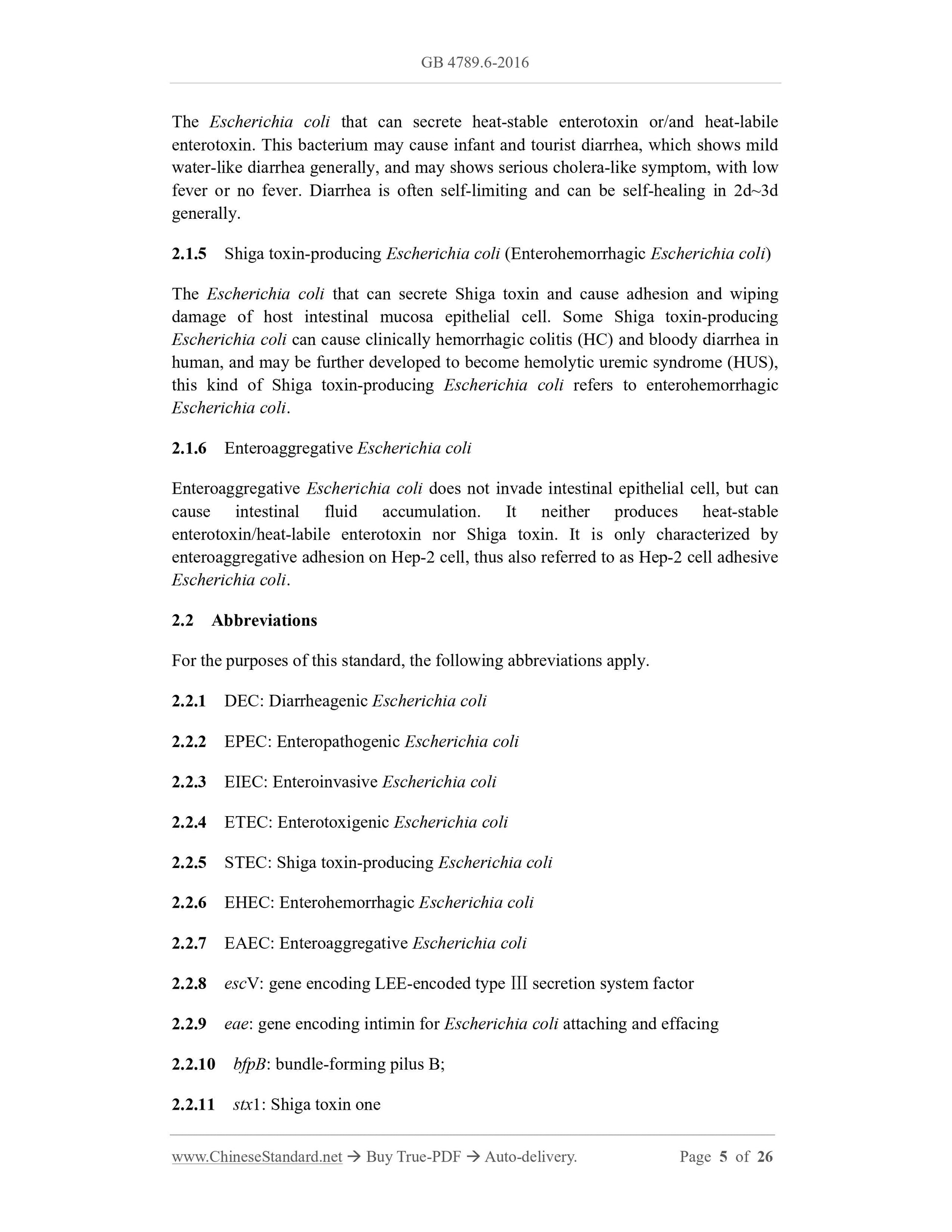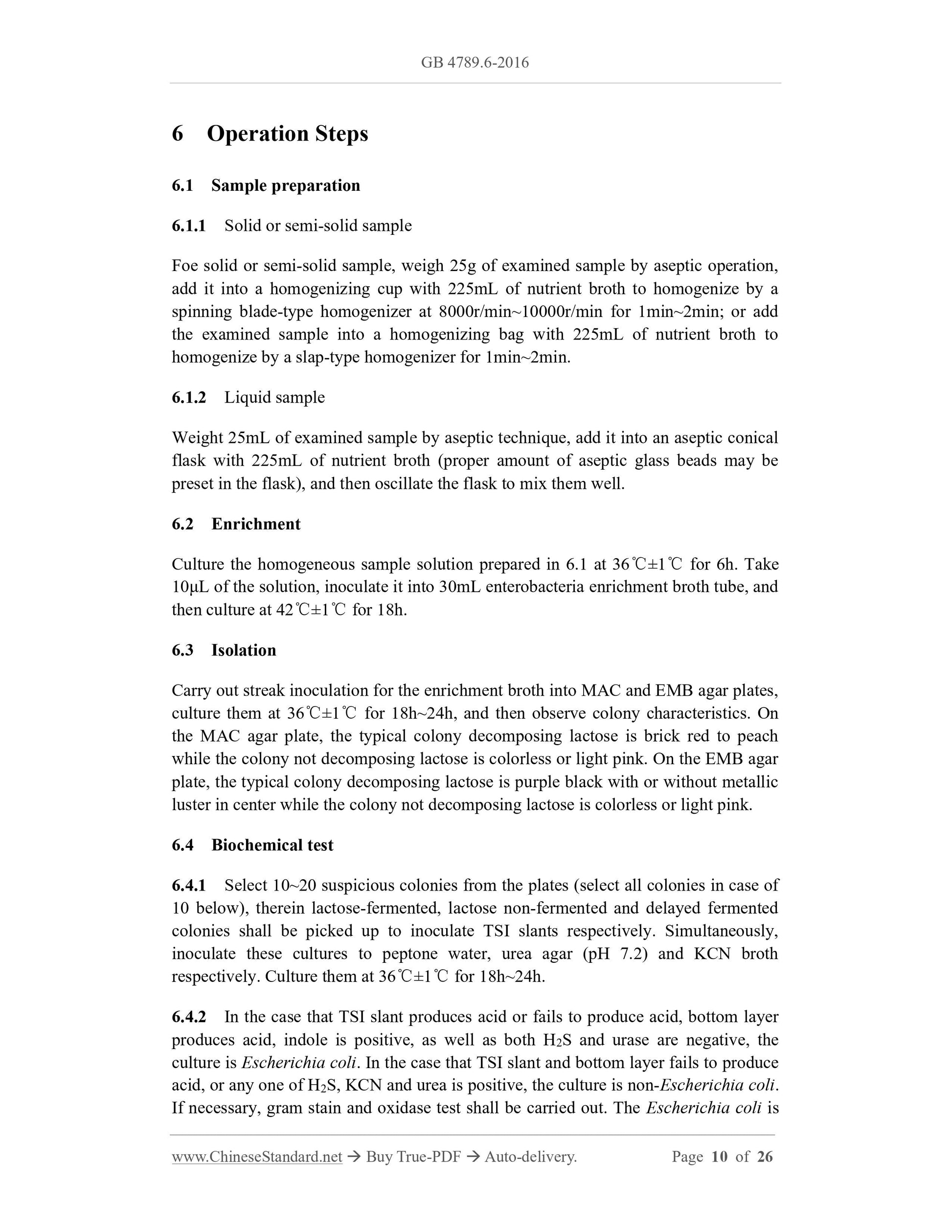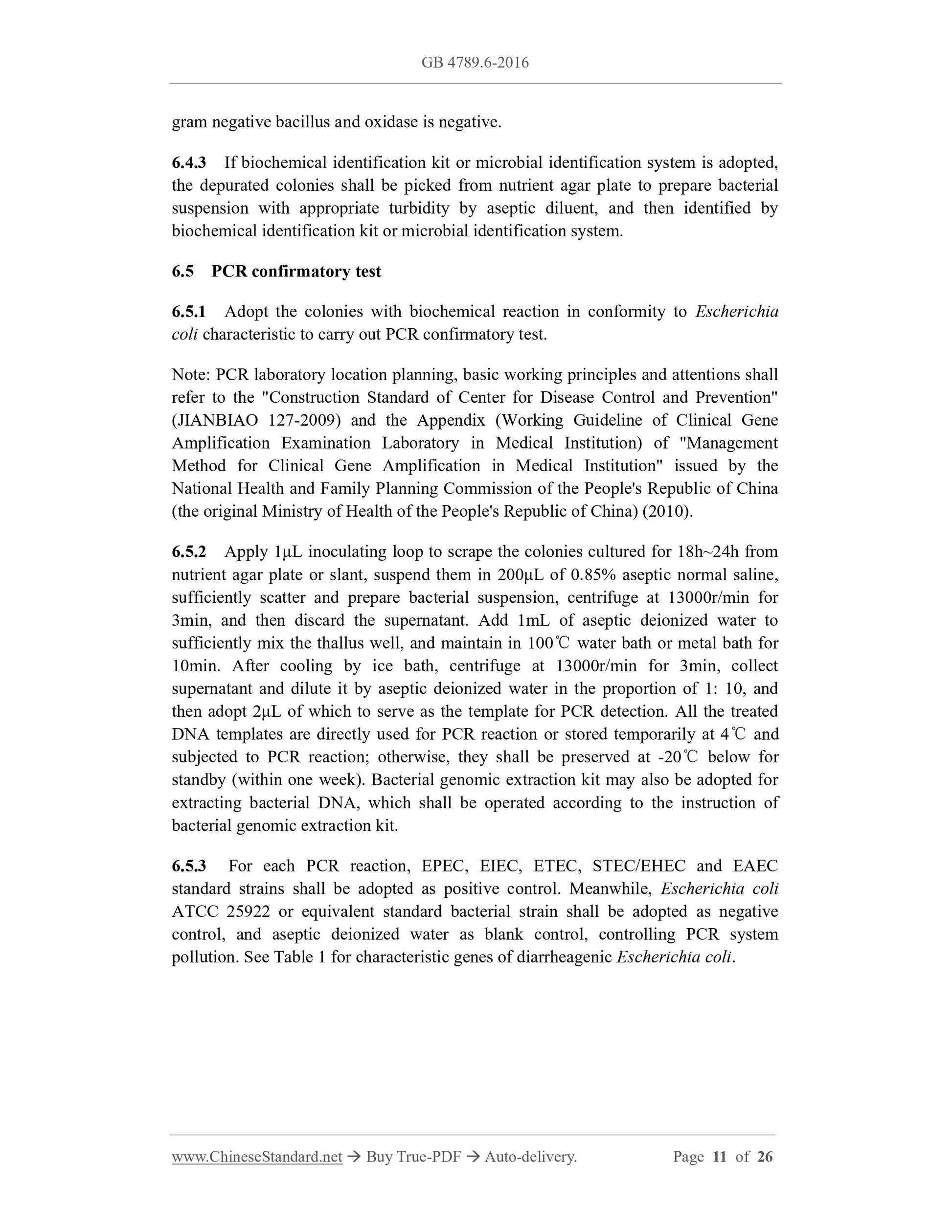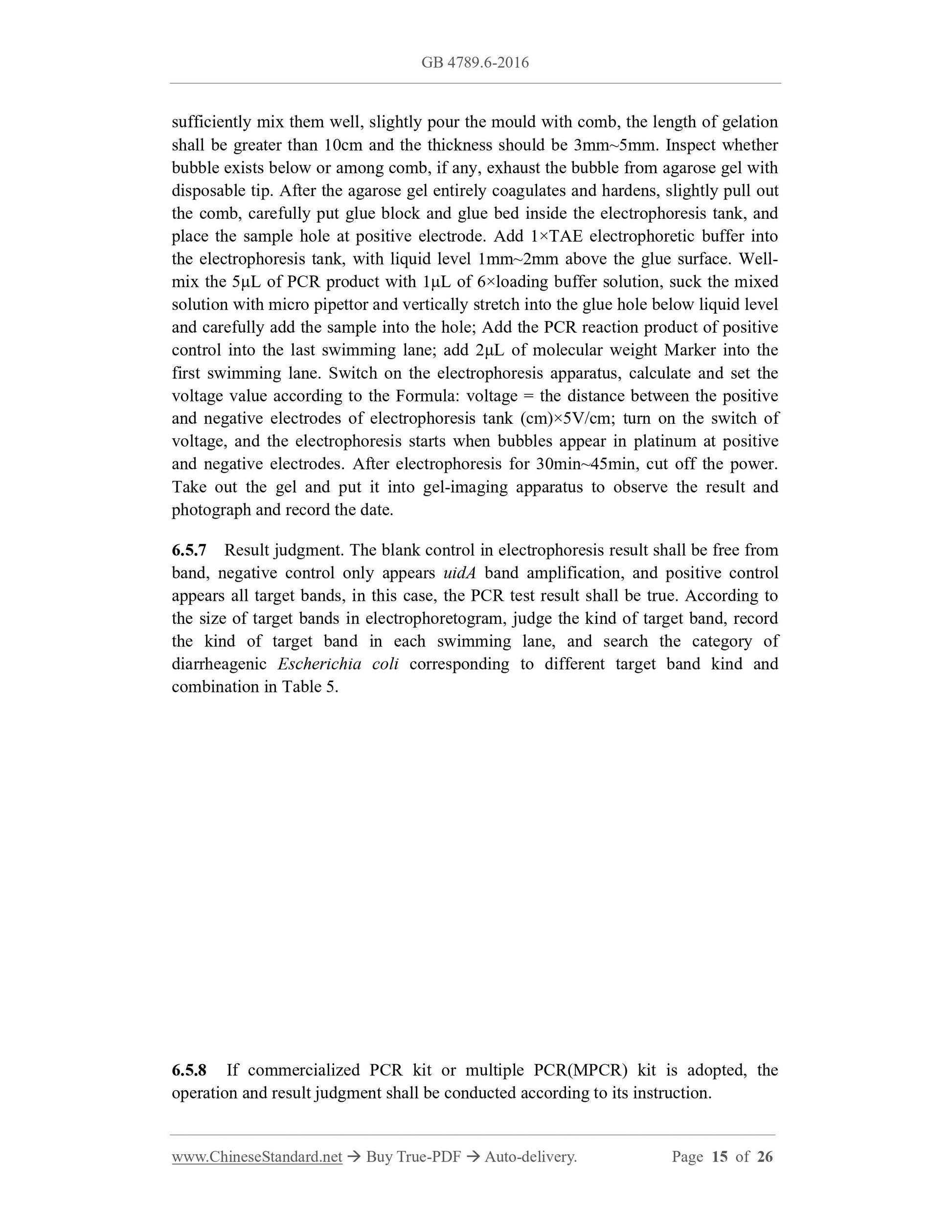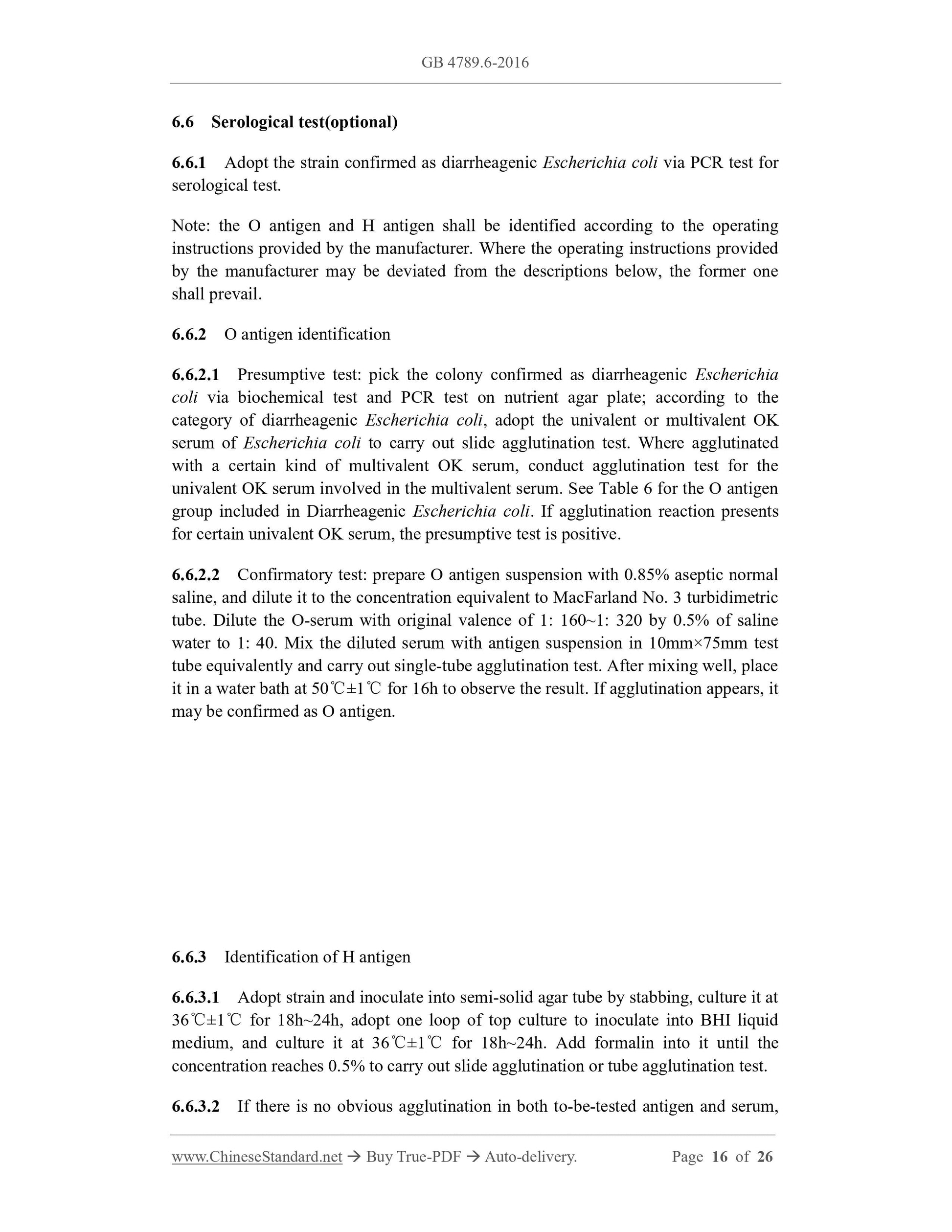1
/
of
8
PayPal, credit cards. Download editable-PDF and invoice in 1 second!
GB 4789.6-2016 English PDF
GB 4789.6-2016 English PDF
Regular price
$155.00 USD
Regular price
Sale price
$155.00 USD
Unit price
/
per
Shipping calculated at checkout.
Couldn't load pickup availability
Delivery: 3 seconds. Download true-PDF + Invoice.
Get QUOTATION in 1-minute: Click GB 4789.6-2016
Historical versions: GB 4789.6-2016
Preview True-PDF (Reload/Scroll if blank)
GB 4789.6-2016: National food safety standard -- Microbiological examination of food -- Examination of diarrheagenic Escherichia coli
GB 4789.6-2016
GB
NATIONAL STANDARD OF THE
PEOPLE’S REPUBLIC OF CHINA
National Food Safety Standard - Food Microbiological
Examination - Diarrheagenic Escherichia Coli
ISSUED ON: DECEMBER 23, 2016
IMPLEMENTED ON: JUNE 23, 2017
Issued by: National Health Commission of the People’s Republic of China;
State Administration for Market Regulation.
Table of Contents
Foreword ... 3
1 Scope ... 4
2 Terms, Definitions and Abbreviations ... 4
3 Apparatus and Materials ... 6
4 Media and Reagents ... 7
5 Examination Procedures ... 8
6 Operation Steps ... 10
7 Result Report ... 17
Appendix A Media and Reagents ... 18
National Food Safety Standard - Food Microbiological
Examination - Diarrheagenic Escherichia Coli
1 Scope
This standard specifies the examination method of diarrheagenic Escherichia coli in
foods.
This standard applies to the examination of diarrheagenic Escherichia coli in foods.
2 Terms, Definitions and Abbreviations
2.1 Terms and definitions
For the purpose of this standard, the following terms and definitions apply.
2.1.1 Diarrheagenic Escherichia coli
A kind of Escherichia coli can cause diarrhea-based symptom in human body via
contaminated food. The common diarrheagenic Escherichia coli mainly includes
enteropathogenic Escherichia coli, enteroinvasive Escherichia coli, enterotoxigenic
Escherichia coli, Shiga toxin-producing Escherichia coli (including
enterohemorrhagic Escherichia coli) and enteroaggregative Escherichia coli.
2.1.2 Enteropathogenic Escherichia coli
The Escherichia coli that can cause adhesion and wiping damage of host intestinal
mucosa epithelial cell and does not produce Shiga toxin. This bacterium is the main
pathogenic bacteria causing infant diarrhea, with high infectivity, which can be fatal
in severe cases.
2.1.3 Enteroinvasive Escherichia coli
The Escherichia coli that can invade intestinal epithelial cell to cause dysentery-like
diarrhea. This bacterium is free from power, lysine decarboxylic reaction and lactose
fermentation, while with both biochemical reaction and antigenic structure
approximate to that of Shigella dysenteriae. The key genes intruding epithelial cell are
antigen encoding gene and controlling gene of invasive plasmid, such as ipaH-gene
and ipaR-gene (also referred to as invE-gene).
2.1.4 Enterotoxigenic Escherichia coli
The Escherichia coli that can secrete heat-stable enterotoxin or/and heat-labile
enterotoxin. This bacterium may cause infant and tourist diarrhea, which shows mild
water-like diarrhea generally, and may shows serious cholera-like symptom, with low
fever or no fever. Diarrhea is often self-limiting and can be self-healing in 2d~3d
generally.
2.1.5 Shiga toxin-producing Escherichia coli (Enterohemorrhagic Escherichia coli)
The Escherichia coli that can secrete Shiga toxin and cause adhesion and wiping
damage of host intestinal mucosa epithelial cell. Some Shiga toxin-producing
Escherichia coli can cause clinically hemorrhagic colitis (HC) and bloody diarrhea in
human, and may be further developed to become hemolytic uremic syndrome (HUS),
this kind of Shiga toxin-producing Escherichia coli refers to enterohemorrhagic
Escherichia coli.
2.1.6 Enteroaggregative Escherichia coli
Enteroaggregative Escherichia coli does not invade intestinal epithelial cell, but can
cause intestinal fluid accumulation. It neither produces heat-stable
enterotoxin/heat-labile enterotoxin nor Shiga toxin. It is only characterized by
enteroaggregative adhesion on Hep-2 cell, thus also referred to as Hep-2 cell adhesive
Escherichia coli.
2.2 Abbreviations
For the purposes of this standard, the following abbreviations apply.
2.2.1 DEC: Diarrheagenic Escherichia coli
2.2.2 EPEC: Enteropathogenic Escherichia coli
2.2.3 EIEC: Enteroinvasive Escherichia coli
2.2.4 ETEC: Enterotoxigenic Escherichia coli
2.2.5 STEC: Shiga toxin-producing Escherichia coli
2.2.6 EHEC: Enterohemorrhagic Escherichia coli
2.2.7 EAEC: Enteroaggregative Escherichia coli
2.2.8 escV: gene encoding LEE-encoded type Ⅲ secretion system factor
2.2.9 eae: gene encoding intimin for Escherichia coli attaching and effacing
2.2.10 bfpB: bundle-forming pilus B;
2.2.11 stx1: Shiga toxin one
6 Operation Steps
6.1 Sample preparation
6.1.1 Solid or semi-solid sample
Foe solid or semi-solid sample, weigh 25g of examined sample by aseptic operation,
add it into a homogenizing cup with 225mL of nutrient broth to homogenize by a
spinning blade-type homogenizer at 8000r/min~10000r/min for 1min~2min; or add
the examined sample into a homogenizing bag with 225mL of nutrient broth to
homogenize by a slap-type homogenizer for 1min~2min.
6.1.2 Liquid sample
Weight 25mL of examined sample by aseptic technique, add it into an aseptic conical
flask with 225mL of nutrient broth (proper amount of aseptic glass beads may be
preset in the flask), and then oscillate the flask to mix them well.
6.2 Enrichment
Culture the homogeneous sample solution prepared in 6.1 at 36℃±1℃ for 6h. Take
10μL of the solution, inoculate it into 30mL enterobacteria enrichment broth tube, and
then culture at 42℃±1℃ for 18h.
6.3 Isolation
Carry out streak inoculation for the enrichment broth into MAC and EMB agar plates,
culture them at 36℃±1℃ for 18h~24h, and then observe colony characteristics. On
the MAC agar plate, the typical colony decomposing lactose is brick red to peach
while the colony not decomposing lactose is colorless or light pink. On the EMB agar
plate, the typical colony decomposing lactose is purple black with or without metallic
luster in center while the colony not decomposing lactose is colorless or light pink.
6.4 Biochemical test
6.4.1 Select 10~20 suspicious colonies from the plates (select all colonies in case of
10 below), therein lactose-fermented, lactose non-fermented and delayed fermented
colonies shall be picked up to inoculate TSI slants respectively. Simultaneously,
inoculate these cultures to peptone water, urea agar (pH 7.2) and KCN broth
respectively. Culture them at 36℃±1℃ for 18h~24h.
6.4.2 In the case that TSI slant produces acid or fails to produce acid, bottom layer
produces acid, indole is positive, as well as both H2S and urase are negative, the
culture is Escherichia coli. In the case that TSI slant and bottom layer fails to produce
acid, or any one of H2S, KCN and urea is positive, the culture is non-Escherichia coli.
If necessary, gram stain and oxidase test shall be carried out. The Escherichia coli is
gram negative bacillus and oxidase is negative.
6.4.3 If biochemical identification kit or microbial identification system is adopted,
the depurated colonies shall be picked from nutrient agar plate to prepare bacterial
suspension with appropriate turbidity by aseptic diluent, and then identified by
biochemical identification kit or microbial identification system.
6.5 PCR confirmatory test
6.5.1 Adopt the colonies with biochemical reaction in conformity to Escherichia
coli characteristic to carry out PCR confirmatory test.
Note: PCR laboratory location planning, basic working principles and attentions shall
refer to the "Construction Standard of Center for Disease Control and Prevention"
(JIANBIAO 127-2009) and the Appendix (Working Guideline of Clinical Gene
Amplification Examination Laboratory in Medical Institution) of "Management
Method for Clinical Gene Amplification in Medical Institution" issued by the
National Health and Family ...
Get QUOTATION in 1-minute: Click GB 4789.6-2016
Historical versions: GB 4789.6-2016
Preview True-PDF (Reload/Scroll if blank)
GB 4789.6-2016: National food safety standard -- Microbiological examination of food -- Examination of diarrheagenic Escherichia coli
GB 4789.6-2016
GB
NATIONAL STANDARD OF THE
PEOPLE’S REPUBLIC OF CHINA
National Food Safety Standard - Food Microbiological
Examination - Diarrheagenic Escherichia Coli
ISSUED ON: DECEMBER 23, 2016
IMPLEMENTED ON: JUNE 23, 2017
Issued by: National Health Commission of the People’s Republic of China;
State Administration for Market Regulation.
Table of Contents
Foreword ... 3
1 Scope ... 4
2 Terms, Definitions and Abbreviations ... 4
3 Apparatus and Materials ... 6
4 Media and Reagents ... 7
5 Examination Procedures ... 8
6 Operation Steps ... 10
7 Result Report ... 17
Appendix A Media and Reagents ... 18
National Food Safety Standard - Food Microbiological
Examination - Diarrheagenic Escherichia Coli
1 Scope
This standard specifies the examination method of diarrheagenic Escherichia coli in
foods.
This standard applies to the examination of diarrheagenic Escherichia coli in foods.
2 Terms, Definitions and Abbreviations
2.1 Terms and definitions
For the purpose of this standard, the following terms and definitions apply.
2.1.1 Diarrheagenic Escherichia coli
A kind of Escherichia coli can cause diarrhea-based symptom in human body via
contaminated food. The common diarrheagenic Escherichia coli mainly includes
enteropathogenic Escherichia coli, enteroinvasive Escherichia coli, enterotoxigenic
Escherichia coli, Shiga toxin-producing Escherichia coli (including
enterohemorrhagic Escherichia coli) and enteroaggregative Escherichia coli.
2.1.2 Enteropathogenic Escherichia coli
The Escherichia coli that can cause adhesion and wiping damage of host intestinal
mucosa epithelial cell and does not produce Shiga toxin. This bacterium is the main
pathogenic bacteria causing infant diarrhea, with high infectivity, which can be fatal
in severe cases.
2.1.3 Enteroinvasive Escherichia coli
The Escherichia coli that can invade intestinal epithelial cell to cause dysentery-like
diarrhea. This bacterium is free from power, lysine decarboxylic reaction and lactose
fermentation, while with both biochemical reaction and antigenic structure
approximate to that of Shigella dysenteriae. The key genes intruding epithelial cell are
antigen encoding gene and controlling gene of invasive plasmid, such as ipaH-gene
and ipaR-gene (also referred to as invE-gene).
2.1.4 Enterotoxigenic Escherichia coli
The Escherichia coli that can secrete heat-stable enterotoxin or/and heat-labile
enterotoxin. This bacterium may cause infant and tourist diarrhea, which shows mild
water-like diarrhea generally, and may shows serious cholera-like symptom, with low
fever or no fever. Diarrhea is often self-limiting and can be self-healing in 2d~3d
generally.
2.1.5 Shiga toxin-producing Escherichia coli (Enterohemorrhagic Escherichia coli)
The Escherichia coli that can secrete Shiga toxin and cause adhesion and wiping
damage of host intestinal mucosa epithelial cell. Some Shiga toxin-producing
Escherichia coli can cause clinically hemorrhagic colitis (HC) and bloody diarrhea in
human, and may be further developed to become hemolytic uremic syndrome (HUS),
this kind of Shiga toxin-producing Escherichia coli refers to enterohemorrhagic
Escherichia coli.
2.1.6 Enteroaggregative Escherichia coli
Enteroaggregative Escherichia coli does not invade intestinal epithelial cell, but can
cause intestinal fluid accumulation. It neither produces heat-stable
enterotoxin/heat-labile enterotoxin nor Shiga toxin. It is only characterized by
enteroaggregative adhesion on Hep-2 cell, thus also referred to as Hep-2 cell adhesive
Escherichia coli.
2.2 Abbreviations
For the purposes of this standard, the following abbreviations apply.
2.2.1 DEC: Diarrheagenic Escherichia coli
2.2.2 EPEC: Enteropathogenic Escherichia coli
2.2.3 EIEC: Enteroinvasive Escherichia coli
2.2.4 ETEC: Enterotoxigenic Escherichia coli
2.2.5 STEC: Shiga toxin-producing Escherichia coli
2.2.6 EHEC: Enterohemorrhagic Escherichia coli
2.2.7 EAEC: Enteroaggregative Escherichia coli
2.2.8 escV: gene encoding LEE-encoded type Ⅲ secretion system factor
2.2.9 eae: gene encoding intimin for Escherichia coli attaching and effacing
2.2.10 bfpB: bundle-forming pilus B;
2.2.11 stx1: Shiga toxin one
6 Operation Steps
6.1 Sample preparation
6.1.1 Solid or semi-solid sample
Foe solid or semi-solid sample, weigh 25g of examined sample by aseptic operation,
add it into a homogenizing cup with 225mL of nutrient broth to homogenize by a
spinning blade-type homogenizer at 8000r/min~10000r/min for 1min~2min; or add
the examined sample into a homogenizing bag with 225mL of nutrient broth to
homogenize by a slap-type homogenizer for 1min~2min.
6.1.2 Liquid sample
Weight 25mL of examined sample by aseptic technique, add it into an aseptic conical
flask with 225mL of nutrient broth (proper amount of aseptic glass beads may be
preset in the flask), and then oscillate the flask to mix them well.
6.2 Enrichment
Culture the homogeneous sample solution prepared in 6.1 at 36℃±1℃ for 6h. Take
10μL of the solution, inoculate it into 30mL enterobacteria enrichment broth tube, and
then culture at 42℃±1℃ for 18h.
6.3 Isolation
Carry out streak inoculation for the enrichment broth into MAC and EMB agar plates,
culture them at 36℃±1℃ for 18h~24h, and then observe colony characteristics. On
the MAC agar plate, the typical colony decomposing lactose is brick red to peach
while the colony not decomposing lactose is colorless or light pink. On the EMB agar
plate, the typical colony decomposing lactose is purple black with or without metallic
luster in center while the colony not decomposing lactose is colorless or light pink.
6.4 Biochemical test
6.4.1 Select 10~20 suspicious colonies from the plates (select all colonies in case of
10 below), therein lactose-fermented, lactose non-fermented and delayed fermented
colonies shall be picked up to inoculate TSI slants respectively. Simultaneously,
inoculate these cultures to peptone water, urea agar (pH 7.2) and KCN broth
respectively. Culture them at 36℃±1℃ for 18h~24h.
6.4.2 In the case that TSI slant produces acid or fails to produce acid, bottom layer
produces acid, indole is positive, as well as both H2S and urase are negative, the
culture is Escherichia coli. In the case that TSI slant and bottom layer fails to produce
acid, or any one of H2S, KCN and urea is positive, the culture is non-Escherichia coli.
If necessary, gram stain and oxidase test shall be carried out. The Escherichia coli is
gram negative bacillus and oxidase is negative.
6.4.3 If biochemical identification kit or microbial identification system is adopted,
the depurated colonies shall be picked from nutrient agar plate to prepare bacterial
suspension with appropriate turbidity by aseptic diluent, and then identified by
biochemical identification kit or microbial identification system.
6.5 PCR confirmatory test
6.5.1 Adopt the colonies with biochemical reaction in conformity to Escherichia
coli characteristic to carry out PCR confirmatory test.
Note: PCR laboratory location planning, basic working principles and attentions shall
refer to the "Construction Standard of Center for Disease Control and Prevention"
(JIANBIAO 127-2009) and the Appendix (Working Guideline of Clinical Gene
Amplification Examination Laboratory in Medical Institution) of "Management
Method for Clinical Gene Amplification in Medical Institution" issued by the
National Health and Family ...
Share
